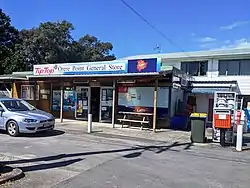Ōrere Point | |
|---|---|
Rural settlement | |
 Orere Point General Store | |
| Coordinates: 36°58′S 175°15′E / 36.967°S 175.250°E | |
| Country | New Zealand |
| Region | Auckland Region |
| Ward | Franklin ward |
| Board | Franklin Local Board |
| Electorates | |
| Government | |
| • Territorial authority | Auckland Council |
| Area | |
| • Total | 0.80 km2 (0.31 sq mi) |
| Population (June 2023)[2] | |
| • Total | 350 |
| • Density | 440/km2 (1,100/sq mi) |
Ōrere Point is a rural township in the Auckland Region. It is located on the Hauraki Gulf just outside the Auckland metropolitan area. Facilities include a local store, playground, campground, picnic area, parking and limited mobility toilets. Activities include wild life watching, fishing and swimming.[3]
The name was altered to include a macron in 2019.[4]
Demographics
Ōrere Point is defined by Statistics New Zealand as a rural settlement and covers 0.80 km2 (0.31 sq mi)[1] and had an estimated population of 350 as of June 2023,[2] with a population density of 438 people per km2. It is part of the wider Kawakawa Bay-Orere statistical area.[5]
| Year | Pop. | ±% p.a. |
|---|---|---|
| 2006 | 324 | — |
| 2013 | 285 | −1.82% |
| 2018 | 348 | +4.08% |
| Source: [6] | ||


Ōrere Point had a population of 348 at the 2018 New Zealand census, an increase of 63 people (22.1%) since the 2013 census, and an increase of 24 people (7.4%) since the 2006 census. There were 174 households, comprising 183 males and 162 females, giving a sex ratio of 1.13 males per female, with 42 people (12.1%) aged under 15 years, 21 (6.0%) aged 15 to 29, 192 (55.2%) aged 30 to 64, and 96 (27.6%) aged 65 or older.
Ethnicities were 85.3% European/Pākehā, 18.1% Māori, 7.8% Pacific peoples, 2.6% Asian, and 0.9% other ethnicities. People may identify with more than one ethnicity.
Although some people chose not to answer the census's question about religious affiliation, 48.3% had no religion, 31.9% were Christian, 1.7% had Māori religious beliefs and 1.7% had other religions.
Of those at least 15 years old, 48 (15.7%) people had a bachelor's or higher degree, and 84 (27.5%) people had no formal qualifications. 51 people (16.7%) earned over $70,000 compared to 17.2% nationally. The employment status of those at least 15 was that 132 (43.1%) people were employed full-time, 33 (10.8%) were part-time, and 9 (2.9%) were unemployed.[6]
Education
Ōrere School is a coeducational full primary school (years 1–8) with a roll of 33 as of April 2023.[7][8] The school was founded in 1890, and held a reunion in 2015 to celebrate 125 years.[9]
References
- 1 2 "ArcGIS Web Application". statsnz.maps.arcgis.com. Retrieved 16 May 2021.
- 1 2 "Subnational population estimates (RC, SA2), by age and sex, at 30 June 1996-2023 (2023 boundaries)". Statistics New Zealand. Retrieved 25 October 2023. (regional councils); "Subnational population estimates (TA, SA2), by age and sex, at 30 June 1996-2023 (2023 boundaries)". Statistics New Zealand. Retrieved 25 October 2023. (territorial authorities); "Subnational population estimates (urban rural), by age and sex, at 30 June 1996-2023 (2023 boundaries)". Statistics New Zealand. Retrieved 25 October 2023. (urban areas)
- ↑ Guide, The Swim. "Orere Point Beach". Swim Guide. Retrieved 3 February 2020.
- ↑ "Notice of Approved Official Geographic Names". New Zealand Gazette. 21 June 2019.
- ↑ 2018 Census place summary: Kawakawa Bay-Orere
- 1 2 "Statistical area 1 dataset for 2018 Census". Statistics New Zealand. March 2020. 7007096, 7007097 and 7007098.
- ↑ "New Zealand Schools Directory". New Zealand Ministry of Education. Retrieved 12 December 2022.
- ↑ Education Counts: Orere School
- ↑ "Old schools pals meet for milestone". Papakura Courier. 31 August 2015.